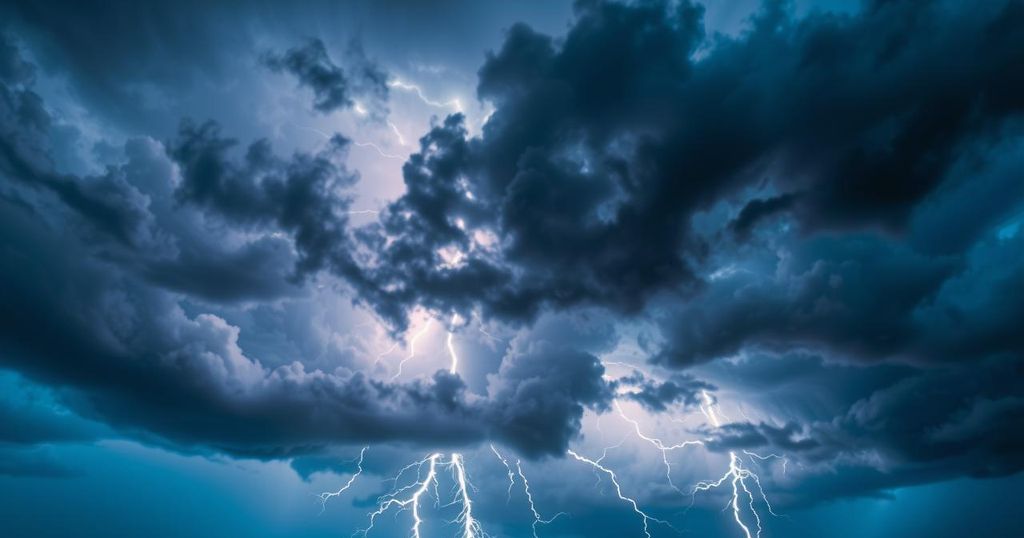Storms in Northern India Claims Lives Amidst Unusual Weather Patterns
A thunderstorm in northern India resulted in 59 deaths, attributed to unusual weather patterns influenced by persistent winter disturbances and atmospheric changes linked to Arctic warming. Experts warn of substantial implications for the upcoming monsoon season and the region’s agricultural stability.
A recent deadly thunderstorm in northern India has claimed at least 59 lives, highlighting the dangerous impact of unusual weather patterns. The storm struck late Wednesday, primarily affecting two states. Officials assert that this catastrophe is a consequence of a complex interaction of atmospheric phenomena, which includes multiple cyclonic circulations and moisture influx from nearby seas, all amplified by unexpectedly persistent winter weather disturbances known as Western Disturbances.
Meteorologists have noted that this cocktail of conditions, influenced by climate patterns far from India, is increasingly common. In particular, record heat recorded in the Arctic Circle has been credited with forcing cold air masses southward, resulting in unseasonable weather, including extreme cold on the US Eastern Seaboard. Such atmospheric shifts have implications for regions like India, where weather patterns are currently under strain.
M. Rajeevan, a former secretary at the Ministry of Earth Sciences, emphasized that Western Disturbances, which generally affect northern India in winter, have lingered far longer into the summer than usual. “You expect western disturbances to move north of the Indian region in April, May, June months,” he stated. In recent years, their prolonged presence into summer may jeopardize the monsoon season, which is critical for agriculture across the nation.
Research backs Rajeevan’s observations, indicating shifts in weather patterns that correlate with diminishing Arctic sea ice. This melting ice affects mid-latitude circulation and consequently exacerbates extremes in monsoon conditions. With the simultaneous presence of cyclonic circulation and moisture-rich systems, instability in the atmosphere led to the formation of thunderstorms, which Rajeevan described as abnormalities, albeit not impossible.
Even though the Indian Meteorological Department (IMD) confirmed no active disturbances over northwest India on the day of the storm, some experts claim mild western disturbances are still influencing current weather. Skymet’s vice president, Mahesh Palawat, explained that cyclonic activities over regions like Punjab are contributing to ongoing thunderstorm conditions across Northwest India. “Due to this cyclonic circulation, a trough extends from south Punjab to northeast India,” he pointed out.
The storm’s fallout was severely felt in Uttar Pradesh, particularly in West UP, where the fatalities resulted from a mix of hazards—lightning, structural collapses, and falling trees. Among those lost were a 65-year-old man in Saharanpur and a six-year-old girl in Sonbhadra, with structural disasters also claiming lives in Firozabad and Kannauj. In addition, a police constable in Bijnor died due to a collision with a tree felled by the storm, illustrating the breadth of destruction.
The storm’s violence was palpable in Delhi, where wind speeds reached cyclonic levels—evident by the sharp drop in temperature from 37°C to 23°C within an hour, alongside significant rainfall. Commotion ensued at the capital’s airport with numerous flight diversions and delays, while storm-related damage affected Metro train services and triggered hailstorms across segments of the city.
Looking ahead, a new low-pressure area over the Arabian Sea could lead to an early monsoon onset in Kerala, a few days ahead of the expected June 1 schedule. However, Rajeevan cautioned that the persistence of Western Disturbances could hinder this progression, complicating the critical northward movement of the monsoon.
The recent thunderstorms serve as a significant reminder of how interlinked global climate conditions manifest in specific local weather disturbances. The emerging patterns may carry serious consequences that could transform agricultural practices and urban stability—a reality that hundreds of millions across India are facing as they depend on the rains for their livelihoods.
Overall, experts stress the importance of monitoring these weather changes closely, as ongoing patterns could alter the very fabric of the Indian monsoon system, bringing far-reaching repercussions for its populace.
The recent thunderstorms in northern India, resulting in at least 59 fatalities, underscore the profound impact of shifting weather patterns influenced by both local and global factors. The persistence of Western Disturbances into summer, exacerbated by atmospheric disruptions linked to Arctic warming, pose significant challenges ahead for the monsoon season. Consequently, understanding these interrelated phenomena is crucial, as they potentially reshape agriculture and urban infrastructure, highlighting the urgent need to monitor climate-related changes closely.
Original Source: www.hindustantimes.com




Post Comment